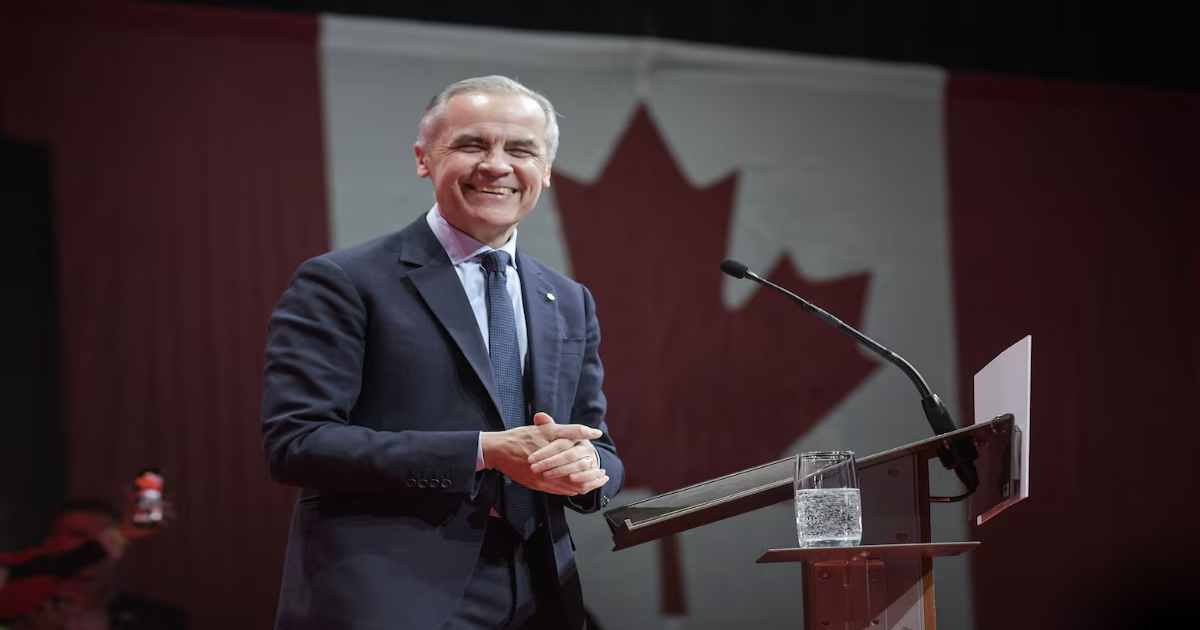- Canada’s tariff-war election ended in triumph for Mark Carney – a central banker who, until last month, had never held political office – and the Liberals, who will return to power in a new minority Parliament. Mr. Carney’s next steps are to make a new cabinet and begin the trade talks he promised to U.S. President Donald Trump.
- Pierre Poilievre, projected to lose his suburban Ottawa riding to a Liberal, pledged to stay on as Conservative Leader after his party made gains in the Toronto area and B.C., and stayed strong in his home province of Alberta, but not enough to form government.
- The Bloc Québécois, diminished in Quebec but still the third largest faction in the House, could hold the balance of power now that the NDP has lost official party status and its leader, Jagmeet Singh, was defeated in his riding. Mr. Singh promised to step down once an interim replacement is available.
- Canada’s Prime Minister Mark Carney gestures at the Liberal Party election night headquarters in Ottawa.Blair Gable/Reuters

- Mark Carney dances to Canadian band Down With Webster as they play live at campaign headquarters after the Liberal Party win.Sean Kilpatrick/The Canadian Press
- Conservative leader Pierre Poilievre speaks to the crowd in an election that saw his party pick up new seats across the country but failed to form government.Ashley Fraser/The Globe and Mail
- Mark Carney shakes hands with his supporters after winning the federal election.Fred Lum/The Globe and Mail
- Bloc Quebecois leader Yves-Francois Blanchet hugs candidate Louis-Philippe Sauve at his election night headquarters.Mathieu Belanger/Reuters
- Conservative leader Pierre Poilievre speaks to the crowd at the election night.Ashley Fraser/The Globe and Mail
- Liberal supporters at Mark Carney’s election night party celebrate.Fred Lum/The Globe and Mail
- New Democratic Party (NDP) leader Jagmeet Singh enters with his wife Gurkiran Kaur Sidhu at his election night headquarters in Burnaby.Chris Helgren/Reuters
- Supporters reacting as it’s announced the Conservative Party failed to form government.Ashley Fraser/The Globe and Mail
- Mark Carney on stage after Canadians gave the Liberal Party its fourth mandate since 2015.Fred Lum/The Globe and Mail
- Liberal supporters at Mark Carney’s election night party.Fred Lum/The Globe and Mail
- Conservative leader Pierre Poilievre speaks to the crowd at the election night event.Ashley Fraser/The Globe and Mail
- Bloc Quebecois Leader Yves-Francois Blanchet speaks to supporters on election night, in Montreal.Christopher Katsarov/The Canadian Press
- Wearing hockey jerseys, Larry Richard (L) and Steven Schumann attend Mark Carney’s election night gathering at TD Place in Ottawa.Fred Lum/The Globe and Mail
- Supporters reacting as television channels declared a Liberal government at Conservative leader Pierre Poilievre’s election night event.Ashley Fraser/The Globe and Mail
- Conservative Leader Pierre Poilievre and his wife Anaida Poilievre wave as they leave the stage at his campaign headquarters on election night.Ashley Fraser/The Globe and Mail
- Bloc Quebecois leader Yves-Francois Blanchet greets a supporter at his election night headquarters in Montreal.Mathieu Belanger/Reuters
- New Democratic Party (NDP) leader Jagmeet Singh gestures alongside his wife Gurkiran Kaur Sidhu at his election night.Chris Helgren/Reuters
To win a majority in this election, a party needed at least 172 seats in the House. None succeeded on Monday night, but the Liberals came closer to the mark than they were under Justin Trudeau, whose resignation made way for Mark Carney to become Prime Minister.
The Canada-U.S. tariff war and President Donald Trump’s annexation rhetoric propelled most federalist voters to the Liberals – who peeled away crucial Quebec ridings from the Bloc, but faced disappointment in Ontario’s 905 region – or the Conservatives, who got their biggest share of the popular vote since Stephen Harper’s era, but could not translate that into enough seats.
The fate of the Conservative, Liberal and NDP leaders’ ridings tells us a lot about how the election went overall. Mr. Carney, who had never held elected office before, and Pierre Poilievre, an MP for more than 20 years, ran in neighbouring parts of suburban Ottawa. Whereas Nepean voters turned out comfortably for Mr. Carney, Carleton voters are projected to replace Mr. Poilievre with Bruce Fanjoy, a Liberal. And far to the west, in Burnaby Central, Jagmeet Singh fell to a distant third behind the Liberal and Conservative challengers, losing the seat before he pledged to step down as NDP leader.
Public opinion polls, including Nanos Research’s findings for The Globe and Mail, more or less accurately anticipated the surge in support for the Liberals and Conservatives, but some misjudged how deeply the New Democrats would lose. “The NDP are about to hit a historic low in popular support never seen before,” chief data scientist Nik Nanos said, adding that the drops in New Democrat and Bloc support were within his pollsters’ margin of error.
Elections Canada’s turnout figures are preliminary, but overall, as experts expected, it does not break records in the way that advance polls did over the Easter weekend. Turnout is higher than recent campaigns, but it would have had to reach 75.3 per cent to match the consequential elections of 1984 and 1988, which, like this one, centred on Canada-U.S. relations and trade.
Implementing Mr. Carney’s agenda will be a delicate process in a Parliament where the Liberals need help to govern, but their previous federalist partner, the New Democrats, are in no shape to offer it. Here’s what we can expect within the next two weeks:
- Cabinet making: Mr. Carney took office in March with a 24-person cabinet, and the new one will be no more than 30, a senior Liberal official told The Globe.
- Recalling the House: Official business has been on hold since January, when Justin Trudeau resigned, but MPs could be back in session shortly after the cabinet is sworn in.
Once Parliament returns, a Throne Speech will set out what the Liberals plan to do first. Trade and the economy are among the top issues for the next government to address, but not the only ones.
- Trade talks: Mr. Trump and Mr. Carney agreed in early April to reconvene after the election and sort out the Canada-U.S. trade relationship more formally. Canada has until May 3 till another Trump tariff measure kicks in, a levy on auto parts.
- Tax cuts: One of Mr. Carney’s promises was a middle-class tax cut, which, by his party’s estimates, would save two-income families up to $825 annually.
- Carbon pricing: When Mr. Carney dialled down the consumer carbon price to zero on his first day in office, it did not change the legislation that keeps the contentious policy in place. It will take Parliament to amend those laws.
- Housing: The promised Build Canada Homes program aims to stimulate construction of 500,000 new homes per year, and give GST breaks to first-time homebuyers.
Mr. Trump shared more of his “51st state” rhetoric on Truth Social while polls were open on Monday, but it’s anyone’s guess what he will say or do about the new government now that it’s been chosen. Leaders in Europe and Australia were first to respond to Mr. Carney’s victory, congratulating him and underlining their countries’ ties with Canada.
Compiled by Globe staff
With reports from Bill Curry, Stephanie Levitz, Robert Fife, Steven Chase, Marie Woolf, Eric Andrew-Gee and Paul Waldie
Andrew Coyne: Trump vs. change made for an uncertain mandate
Shannon Proudfoot: Election hopes deflate at Tory HQ
Tony Keller: This election came down to ‘who do you trust?’
Profile: Is Mark Carney a shrewd strategist or just lucky? Both, say those who know him
East to West: In The Globe’s election postcards, anxiety and endurance were the only constants
Platform guide: Compare pledges on issues from Trump to housing



